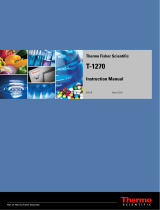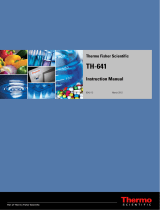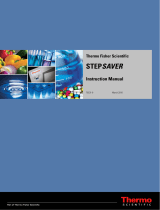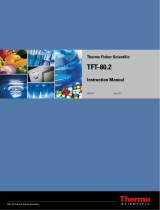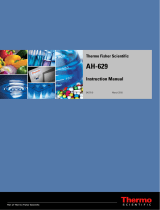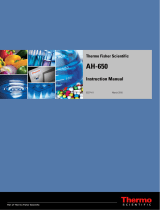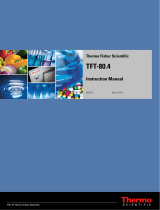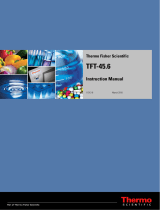Page is loading ...

11670-8 March 2010
Thermo Fisher Scientific
TV-1665
Instruction Manual

© 2009 Thermo Fisher Scientific Inc. All rights reserved.
ULTRACRIMP< is either a registered trademark or a trademark of Thermo Fisher Scientific.
All other trademarks are the property of Thermo Fisher Scientific Inc. and its subsidiaries.
Thermo Fisher Scientific Inc. provides this document to its customers with a product purchase to use in the
product operation. This document is copyright protected and any reproduction of the whole or any part of this
document is strictly prohibited, except with the written authorization of Thermo Fisher Scientific Inc.
The contents of this document are subject to change without notice. All technical information in this
document is for reference purposes only. System configurations and specifications in this document supersede
all previous information received by the purchaser.
Thermo Fisher Scientific Inc. makes no representations that this document is complete, accurate or error-
free and assumes no responsibility and will not be liable for any errors, omissions, damage or loss that might
result from any use of this document, even if the information in the document is followed properly.
This document is not part of any sales contract between Thermo Fisher Scientific Inc. and a purchaser. This
document shall in no way govern or modify any Terms and Conditions of Sale, which Terms and Conditions of
Sale shall govern all conflicting information between the two documents.
Release history: 11670-8 printed in March 2010.
For Research Use Only. Not for use in diagnostic procedures.

Thermo Scientific T-1270 i
T
Thermo Scientific TV-1665 Titanium Vertical Ultracentrifuge Rotor ............................. iii
Important Safety Information ..................................................................................................iv
Chapter 1 DESCRIPTION ........................................................................................................................ 1-1
Rotor Description .................................................................................................... 1-2
Rotor Application .................................................................................................... 1-2
Rotor Specifications ................................................................................................. 1-2
Accessories ............................................................................................................... 1-3
Chapter 2 RUN PREPARATION .............................................................................................................. 2-1
Prerun Safety Checks ............................................................................................... 2-2
Rotor Holding Fixture ............................................................................................. 2-2
Rotor Precool .......................................................................................................... 2-3
Chemical Compatibility .......................................................................................... 2-3
Sample Preparation .................................................................................................. 2-3
Chapter 3 SPECIAL OPERATING CONSIDERATIONS ......................................................................... 3-1
Compartment Loads in Excess of Design Mass ........................................................ 3-2
Precautions to Prevent Precipitation of Cesium Chloride ......................................... 3-2
Critical Speed .......................................................................................................... 3-3
Chapter 4 CARE and MAINTENANCE ................................................................................................... 4-1
Rotor Balancing ....................................................................................................... 4-2
Rotor Loading and Sealing ....................................................................................... 4-3
Rotor Installation ..................................................................................................... 4-5
Acceleration and Deceleration .................................................................................. 4-5
Tube Removal ......................................................................................................... 4-5
Tube Trimmer Accessory (for use with Optional Tubes) ......................................... 4-6
Centrifuge/Rotor Log Book ..................................................................................... 4-6
Chapter 5 TECHNICAL NOTES ............................................................................................................... 5-1
Relative Centrifugal Force (RCF) Determination .................................................... 5-2
Calculation of Sedimentation Time in Aqueous (Non-gradient) Solutions .............. 5-6
Calculation of Sedimentation Time in Gradient Solutions ...................................... 5-6
Chapter 6 DESCRIPTION ........................................................................................................................ 6-1
Corrosion ................................................................................................................ 6-2
Cleaning and Decontamination ............................................................................... 6-2
Overspeed Decal Replacement ................................................................................. 6-3
Storage ..................................................................................................................... 6-3
Inspection ................................................................................................................ 6-3
Service Decontamination Policy .............................................................................. 6-4
Table of contents

Table of contents
ii T-1270 Thermo Scientific
Chemical Compatibility Chart ...............................................................................A-1
Contact Information ................................................................................................B-1

Thermo Scientific TV-1665 iii
P
This manual is a guide for the use of
Thermo Scientific TV-1665 Titanium Vertical
Ultracentrifuge Rotor
Data herein has been verified and is believed adequate for the intended use of the rotor. Because failure
to follow the recommendations set forth in this manual could produce personal injury or property
damage, always follow the recommendations set forth herein. Thermo Fisher Scientific does not
guarantee results and assumes no obligation for the performance of rotors or other products that are
not used in accordance with the instructions provided. This publication is not a license to operate
under, nor a recommendation to infringe upon, any process patents.
Publications prior to the Issue Date of this manual may contain data in apparent conflict with that
provided herein. Please consider all data in this manual to be the most current.
NOTES, CAUTIONS, and WARNINGS within the text of this manual are used to emphasize
important and critical instructions.
WARNING informs the operator of a hazard or unsafe practice that could result in personal injury,
affect the operator's health, or contaminate the environment.
CAUTION informs the operator of an unsafe practice that could result in damage of equipment.
NOTE highlights essential information.
© 1996, 1998, 2001, 2010 by Thermo Fisher Scientific
CAUTION and WARNING are accompanied by a hazard symbol and appear near the
information they correspond to.

Preface
iv TV-1665 Thermo Scientific
Important Safety Information
Certain potentially dangerous conditions are inherent to the use of all centrifuge rotors. To ensure safe
operation of this rotor, anyone using it should be aware of all safe practices and take all precautions
described below and throughout this manual.
WARNING
When using radioactive, toxic, or pathogenic materials, be aware of all characteristics of
the materials and the hazards associated with them in the event leakage occurs during
centrifugation. In the event of a rotor failure, neither the centrifuge nor the rotor can
protect you from particles dispersed in the air. To protect yourself, we recommend
additional precautions be taken to prevent exposure to these materials, for example, use of
controlled ventilation or isolation areas.
Always be aware of the possibility of contamination when using radioactive, toxic, or
pathogenic materials. Take all necessary precautions and use appropriate decontamination
procedures if exposure occurs.
Never use any material capable of producing flammable or explosive vapors or creating
extreme exothermic reactions.
Never exceed the maximum rated speed of the installed rotor; to do so can cause rotor
failure.
Always reduce (derate) rotor speed as instructed in this manual whenever:
•the rotor speed/temperature combination exceeds the solubility of the gradient
material and causes it to precipitate.
•the compartment load exceeds the maximum allowable compartment load specified
(average fluid density is greater than 1.7 g/ml). See Chapter 3, page 3-1.
Failure to reduce rotor speed under these conditions can cause rotor failure.

Preface
Thermo Scientific TV-1665 v
CAUTION
Do not use aluminum rotor components with, or expose them to: strong acids, bases, or
strong laboratory detergents; liquid chlorine bleach; or salts (chlorides) of heavy metals
such as cesium, lead, silver, or mercury. Use of these materials with aluminum can cause a
chemical reaction that initiates corrosion.
Do not operate or precool a rotor at the critical speed, as this will have a detrimental effect
on centrifuge component life. See Chapter 3, page 3-3.
Do not operate the rotor unless it is symmetrically balanced as described in Chapter 4,
page 4-1. Operating the rotor out of balance can cause damage to the centrifuge drive
assembly.
Always maintain the rotor in the recommended manner. The rotor accessories must be
clean and inspected prior to each run: do not use rotors showing signs of corrosion or
cracking. See Chapter 6, Care and Maintenance.


Thermo Scientific TV-1665 1-1
1
DESCRIPTION
This manual provides you with the information that you will need to operate and maintain your
Thermo Fisher Scientific TV-1665 Vertical Ultracentrifuge Rotor. If you encounter any problem
concerning either operation or maintenance that is not covered in the manual, contact Thermo Fisher
Scientific for assistance. In the United States, telephone toll free 1-866-9THERMO. Outside the
United States, contact your distributor or agent for Thermo Fisher Scientific products. Thermo Fisher
Scientific product information is available on our internet web site at http://
www.thermo.com/centrifuge .
Contents
•“Rotor Description” on page 1-2
•“Rotor Application” on page 1-2
•“Rotor Specifications” on page 1-2
•“Accessories” on page 1-3

1 DESCRIPTION
Rotor Description
1-2 TV-1665 Thermo Scientific
Rotor Description
The TV-1665 Rotor assembly consists of sixteen sealing assemblies and a sixteen place compartment
rotor body that is machined from a titanium forging for strength and corrosion resistance. The rotor
has a black coating which provides surface protection and aids temperature regulation. The tube
compartments are bored parallel to the rotor axis and, occasionally, are counterbored to achieve
precision balance. A disc with alternative black and reflective segments is attached to the bottom of
the rotor; this disc will prevent the rotor from being operated at a speed above the recommended
maximum speed of the rotor.
Rotor Application
The TV-1665 Rotor is used in an ultracentrifuge, primarily for density gradient separations; the
design of the vertical rotor allows these separations to be done in shorter times than the conventional
fixedangle or swinging-bucket rotor. Specifically, the TV-1665 can be used for many isopycnic and
some rate zonal applications. Proper operation of the TV-1665 Rotor may require the use of the
automatic slow acceleration and deceleration controls that are standard on all Thermo Fisher
Scientific Ultracentrifuges. Without the use of this feature, the gradient will orient and reorient too
fast — the slow acceleration and slow deceleration prevents disturbance of the gradient.
Rotor Specifications
Table 1-1.Rotor Specifications
Rotor Type Vertical
Maximum Speed (rpm)*
*Speed in revolutions per minute (rpm) is related to angular velocity, ω, according to the following:
Where ω = rad/s. All further references in this manual to speed will be designated as rpm.
65 000**
**With tubes filled with a homogeneous solution having an average density of 1.7 g/ml or less.
Relative Centrifugal Force (RCF) at Max. Speed
- at rmaximum 8.78 cm 414 357
- at raverage 8.12 cm 383 209
- at rminimum 7.46 cm 352 062
K Factor at Maximum Speed 9.8
Number of Tube Compartments 16
Tube Compartment Diameter 13 mm (0.5 inch)
Tube Compartment Length 51 mm (2 inches)
ULTRACRIMP䉸 Tube Volume (Nominal) 6.0 ml
Total Rotor Capacity (Nominal) 96.0 ml
Critical Speed 750 rpm
Maximum Compartment Mass 18.7 grams
Rotor Mass (Weight) 9.07 kg (20 lbs)
ω(rpm)=2π
60
------
⎝⎠
⎛⎞ rpm()0.10472()=

1 DESCRIPTION
Accessories
Thermo Scientific TV-1665 1-3
Accessories
Accessories Supplied
The accessories that are supplied with the TV-1665 Rotor, Catalog No. 11665 (rotor with complete
accessories) are listed in Table 1-2. Those items indicated by an asterisk (*) are not supplied with the
TV-1665 Rotor, Catalog No. 11672, which is the rotor with basic accessories only..
To order replacement accessories, telephone 1-800-522-7746 in the United States. Outside the United
States contact your local representative, distributor, or agent for Thermo Fisher Scientific products. Be
sure to provide a description of the part, catalog number, plus the rotor model and serial number.
Tool Kit, Catalog No. 12770
This kit is required for use with the TV-1665 Rotor when used with the ULTRACRIMP< Sealing
System. Table 1-3 lists the items supplied in the Tool Kit. If you already have these tools, it is not
necessary to order the kit. Any of the tools listed can be ordered individually; to do so, specify the
catalog number given in the table.
Note In order to seal the ULTRACRIMP< Tubes supplied with the rotor (Catalog No. 11665) you
must have an ULTRACRIMP< Sealing Tool (Catalog No. 03920) and a Tool Kit (Catalog No.
12770).
Table 1-2. Accessories Supplied
Quantity Catalog Number Description
4 03945*
*Not supplied with Catalog No. 11672 (rotor with basic accessories only).
ULTRACRIMP䉸 Tubes, Polyallomer, 6.0 ml (package of 50)**
**Each package of tubes is supplied with an equal number of tube caps and tube plugs.
16 03991* Rotor Cap
2 03921*Tube Rack, 4-place (1 pair)
1 12826*Tube Removal Tool
1 51345 Overspeed Decal, 65 000 rpm (extra)
1 51942 Rotor Stand
1 61556 Lubricant
1 52384 Ultraspeed Centrifuge/Rotor Log Book
1 11670 Instruction Manual
Table 1-3. Tool Kit (Catalog No. 12770) for use with ULTRACRIMP䉸 Tube Sealing System
Catalog Number Description
52580 Torque Wrench, 3/8 inch drive
52882 Torque Wrench Socket, 7/16 inch
52540 Rotor Holding Fixture (with mounting screws)

1 DESCRIPTION
Accessories
1-4 TV-1665 Thermo Scientific
Optional Sealing Assembly
If you prefer, you can use the TV-1665 with the optional sealing assembly which consists of a rotor
body cap and a tube plug. When the cap is tightened, the tube plug is pushed into the tube to form
the seal.
To use this style sealing assembly, you must purchase the TV-1665 Rotor with basic accessories only,
Catalog No. 11672; a Tool Kit, Catalog No. 52598; the tubes; and all sealing assembly components
listed in Table 1-4. Table 1-5 lists the components of the Tool Kit; any of the tools listed can also be
purchased individually.
Table 1-4.Optional Multipiece Sealing Assembly Component
Catalog Number Description
52521 Rotor Body Cap, Black (each); 16 required
52522*
*White plugs are for use with polyallomer tubes only.
Tube Plug, White (package of 8)
52387 Tube Trimmer
03127 Tube, Polyallomer (package of 25)
Table 1-5.Tool Kit (Catalog No. 52598) for use with Optional Sealing Assembly
Catalog Number Description
52363 Body Cap Wrench
52540 Rotor Holding Fixture (with mounting screws)

Thermo Scientific TV-1665 2-1
2
RUN PREPARATION
This chapter contains the information necessary to prepare the TV-1665 Rotor for operation and
includes important safety information.
Contents
•“Prerun Safety Checks” on page 2-2
•“Rotor Holding Fixture” on page 2-2
•“Rotor Precool” on page 2-3
•“Chemical Compatibility” on page 2-3
•“Sample Preparation” on page 2-3

2 RUN PREPARATION
Prerun Safety Checks
2-2 TV-1665 Thermo Scientific
Prerun Safety Checks
To ensure safe performance of the rotor, before every run you should:
a. read the Safety Information Page in the front of this manual.
b. make sure each tube compartment is clean and that there is no sign of corrosion.
c. be sure the rotor itself is clean and shows no sign of corrosion or cracking.
d. check the centrifuge chamber and drive spindle to be sure they are clean and free of scratches
and burrs.
e. verify that the proper overspeed decal is firmly attached to the bottom of the rotor; the decal
should have 14 black segments (see page 6-2 for Overspeed Decal Replacement procedure).
f. check the chemical compatibility of all materials used (see Appendix A).
g. be sure that the rotor caps (or body caps) are torqued to the recommended value (see page
4-1, Rotor Loading and Sealing).
h. check that the rotor caps are properly installed.
i. be sure the proper environment has been selected for operation; for example, controlled
ventilation or isolation, if required.
j. check the top speed capability of the tube being used.
Rotor Holding Fixture
The rotor holding fixture (Catalog No. 52540) is used to hold the rotor during the rotor loading and
unloading procedures to prevent disturbance of the gradient.
Secure the fixture to a workbench with the two flathead screws supplied as shown in figure 2-1.
Figure 2-1. Rotor Holding Fixture Installation
CAUTION When using a tube or bottle assembly other than those supplied by Thermo
Fisher Scientific, be sure to check its top speed capability; when in doubt, do a test run for
the desired application. Exceeding the top speed capability of the tube or bottle assembly
can result in its breakage.

2 RUN PREPARATION
Rotor Precool
Thermo Scientific TV-1665 2-3
Rotor Precool
If samples are routinely processed around 4°C or below, the rotor can be stored in a refrigerator or a
cold room. If this is not possible, the rotor can easily be precooled in a Thermo Fisher Scientific
Ultracentrifuge. Refer to the individual Thermo Fisher Scientific Ultracentrifuge Instruction Manual
for precooling directions. Be careful not to precool the rotor at its critical speed (see page 3-3).
Chemical Compatibility
The critical components of the TV-1665 Rotor that are apt to come in contact with solution are: the
rotor body (titanium), the tubes (polyallomer), and all sealing assembly components. ULTRACRIMP<
sealing assembly components include: rotor caps and tube caps (aluminum) and the tube plugs (Buna
N). Optional sealing assembly components include: tube plugs (Delrin®) and rotor body caps
(aluminum).
The chemical compatibility of rotor elements and accessory materials is given in the Appendix. Because
no organized chemical resistance data exists for materials under the stress of centrifugation, this data is
intended to be used only as a guide to the selection of tube materials. When in doubt, we recommend
pretesting of sample lots.
Sample Preparation
ULTRACRIMP< Tubes
Prepare the ULTRACRIMP< tubes for use following the tube filling procedure given in the
ULTRACRIMP< Tube Sealing System Instruction Manual.
Optional Tubes (Catalog No. 03127)
When using tubes, Catalog No. 03127, each tube must contain a total of 4.4 ml of solution; the
recommended capacity for each tube is: 4.0 ml of gradient, 0.2 ml of sample and 0.2 ml of overlay (for
example, mineral oil).
CAUTION To prevent the tube from collapsing or leaking during centrifugation, each tube
must always contain 4.4 ml of solution. Use a new tube for each operation — do not reuse
these tubes.

Thermo Scientific TV-1665 3-1
3
SPECIAL OPERATING CONSIDERATIONS
Follow the instructions in this chapter if your sample has an average fluid density greater than 1.7 g/ml
or if you are using a cesium chloride gradient. You may need to lower the speed of your run to reduce
the stress on the rotor or to prevent cesium chloride from precipitating from solution.
Contents
•“Compartment Loads in Excess of Design Mass” on page 3-2
•“Precautions to Prevent Precipitation of Cesium Chloride” on page 3-2
•“Critical Speed” on page 3-3

3 SPECIAL OPERATING CONSIDERATIONS
Compartment Loads in Excess of Design Mass
3-2 TV-1665 Thermo Scientific
Compartment Loads in Excess of Design Mass
A recommended design mass has been established for each ultracentrifuge rotor representing the
maximum mass that each tube compartment can contain at top speed operation. To prevent rotor
failure, the total contents of each compartment, including specimen, rotor cap, tube cap, tube plug,
and the tube, should not exceed the recommended figure unless rotor speed is reduced
proportionately. (If using the optional sealing assembly, include the weight of all components.)
Strict adherence to the maximum allowable compartment mass or reduced speed is required to
prevent rotor failure. Read the WARNING.
The design mass for each tube compartment of the TV-1665 Rotor is 18.7 grams at 65 000 rpm.
This figure is based on the use of a thinwall polyallomer tube with a liquid at 1.7 specific gravity. If
the density is greater than 1.7 g/ml, use the following formula to determine the reduced speed:
Refer to figures 3-1 for derating factors when using cesium chloride solutions.
Precautions to Prevent Precipitation of Cesium Chloride
Reducing Speed to Prevent Precipitation
Maximum speed must be reduced for an average fluid density greater than 1.7 g/ml (square-root
reduction) to prevent excessive hydraulic pressure in a rotor. Although the standard formula pertains
to sucrose and similar gradient materials, it will not prevent precipitation of heavy crystals when
material such as cesium chloride (CsCl) is used in an ultracentrifuge rotor.
When solid, crystalline CsCl forms, it places a density of 4 g/ml along the outside edge of each tube
compartment. This density is dangerously high and can cause the rotor to fail, with subsequent
sample loss. Therefore, cesium chloride solutions must be run at reduced speeds to avoid this
precipitation. The allowable speed is determined by the average density of the CsCl solution and the
run temperature. Figure 3-1 should be used to determine the maximum operating speed. Curves are
given for specific average densities at 5°C and 25°C that will prevent precipitation. Also, figure 3-1
includes a curve that shows the standard speed (square-root) reduction to avoid excessive hydraulic
pressure only. The standard, square-root reduction formula cannot be used when precipitation of
CsCl must be considered. For example, standard speed reduction allows you to run a solution having
a density of 1.77 g/ml at 53 500 rpm; however, you can see that a cesium chloride solution will
precipitate at this speed. This graph shows that the highest speed you can run a cesium chloride
solution of this density is 43 000 rpm at 25°C or 26 000 rpm at 5°C.
WARNING Always reduce (derate) rotor speed as instructed whenever the compartment
load exceeds the maximum compartment load specified. Failure to reduce rotor speed
under these conditions can cause rotor failure, which may result in centrifuge damage or
personal Injury.
Reduced Speed 65000 1.7
Average Fluid Density (g/ml)
-------------------------------------------------------------------=
Note The solubility limit of cesium chloride in an aqueous solution is 1.86 g/ml at 25°C and 1.81
g/ml at 5°C.

3 SPECIAL OPERATING CONSIDERATIONS
Critical Speed
Thermo Scientific TV-1665 3-3
The Gradient Shape
The curves in figures 3-2 and 3-3 show the gradient shape at equilibrium, 5°C and 25°C respectively,
for tubes filled with a CsCl solution. Using the examples illustrated in figure 3-1. refer to figure 3-2 and
3-3 respectively to determine the shape of the gradient that will be formed at each speed. Interpolate to
find gradient shapes at speeds other than those illustrated.
Effects of Temperature
Solubility limits of CsCl in aqueous solutions are temperature dependent. The solubility limit of 1.86
g/ml at 25°C becomes 1.81 g/ml at 5°C. The curve in figure 3-1 for a 5-degree run shows that the
maximum peed a solution having a density of 1.77 g/ml can be run at is 26 000 rpm, or 17 000 rpm
less than the speed allowed for the same density at 25°C. The maximum run speed for temperatures
other than 5°C and 25°C can be determined by interpolation. Similarly, figures 3-2 and 3-3 show the
gradient shapes at 25°C and 5°C. Again, interpolate to plot the gradient shapes at temperatures
between 5°C and 25°C.
Effects of Reorientation
Figures 3-2, 3-3 and 3-4 can be used to determine the position a band of particles in the tube after
reorientation. Following the same example given in paragraph c, Effects of Temperature, and using
figure 3-2 for 25°C, locate the position of a band of particles after equilibrium, that have a density of
1.76 g/ml. Find 1.76 on the side scale (density, g/ml) and follow the line across until it intersects the
curve for 43 000 rom which, in this case will have to be interpolated. Then follow the line from the
point to the bottom scale to determine the radius of the tube at this point...in this example it is 8.055
cm. Next, refer to figure 3-4 and find 8.05 cm on the side scale – follow the line across from this point
until it intersects the curve; you'll find that the 8.05 cm radius corresponds to 2.33 ml of fluid. This
means that there will be 2.33 ml of gradient above the band and 3.37 ml below the band; therefore,
measuring from the top of the meniscus, the particles will be located at 41% of the fluid column.
To locate the position of a band of particles with the same density (1.76 g/ml) that were run at 5°C, use
figure 3-3. You will find that the band is located at a radius of 7.95 cm, which on figure 3-4,
corresponds to 1.71 ml of fluid, meaning there is 1.71 ml above the band and 3.99 ml below the band.
Again, measuring from the top of the meniscus, the particles will now be located 30% of the fluid
column.
Critical Speed
The critical speed is that speed at which any rotor imbalance will produce a driving frequency equal to
the resonant frequency of the rotating system (that is, the rotor and the centrifuge drive). At this speed,
the rotor may produce large amplitude vibrations which can be felt in the instrument frame. Mass
imbalance will contribute to increased vibration intensity at the critical speed. Avoid operating the
rotor at the critical speed, which is 750 rpm for the TV-1665 Rotor. Operation at the critical speed will
have a detrimental effect on centrifuge component life. Read the CAUTION.
CAUTION Do not operate or precool the rotor at critical speed, because this will have a
detrimental effect on centrifuge component life.

3 SPECIAL OPERATING CONSIDERATIONS
Critical Speed
3-4 TV-1665 Thermo Scientific
Figure 3-1. CsCl Precipitation Curves for TV-1665 Rotor

3 SPECIAL OPERATING CONSIDERATIONS
Critical Speed
Thermo Scientific TV-1665 3-5
Figure 3-2. CsCl Density Gradient Shapes at Equilibrium (25°C)
/
